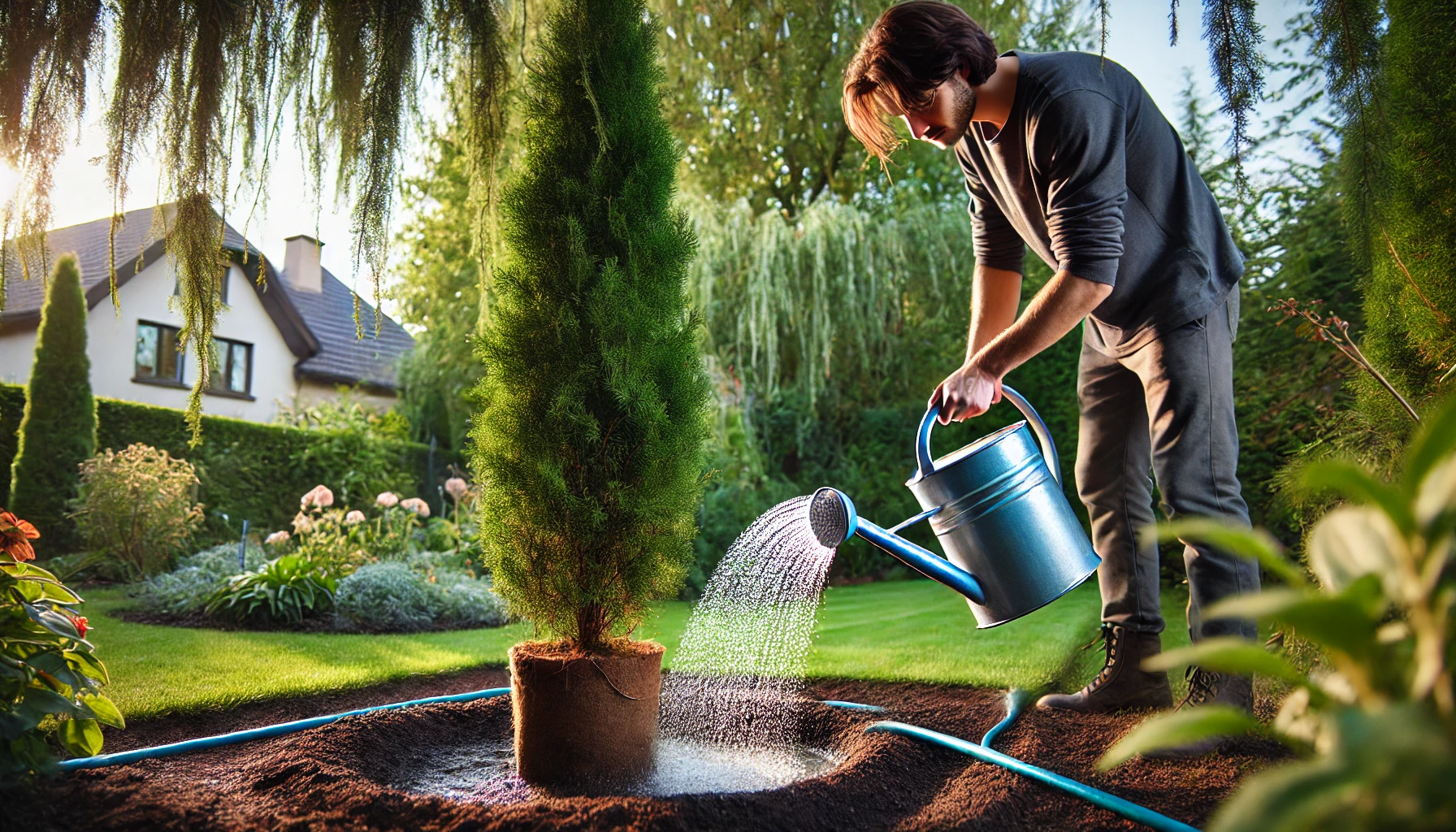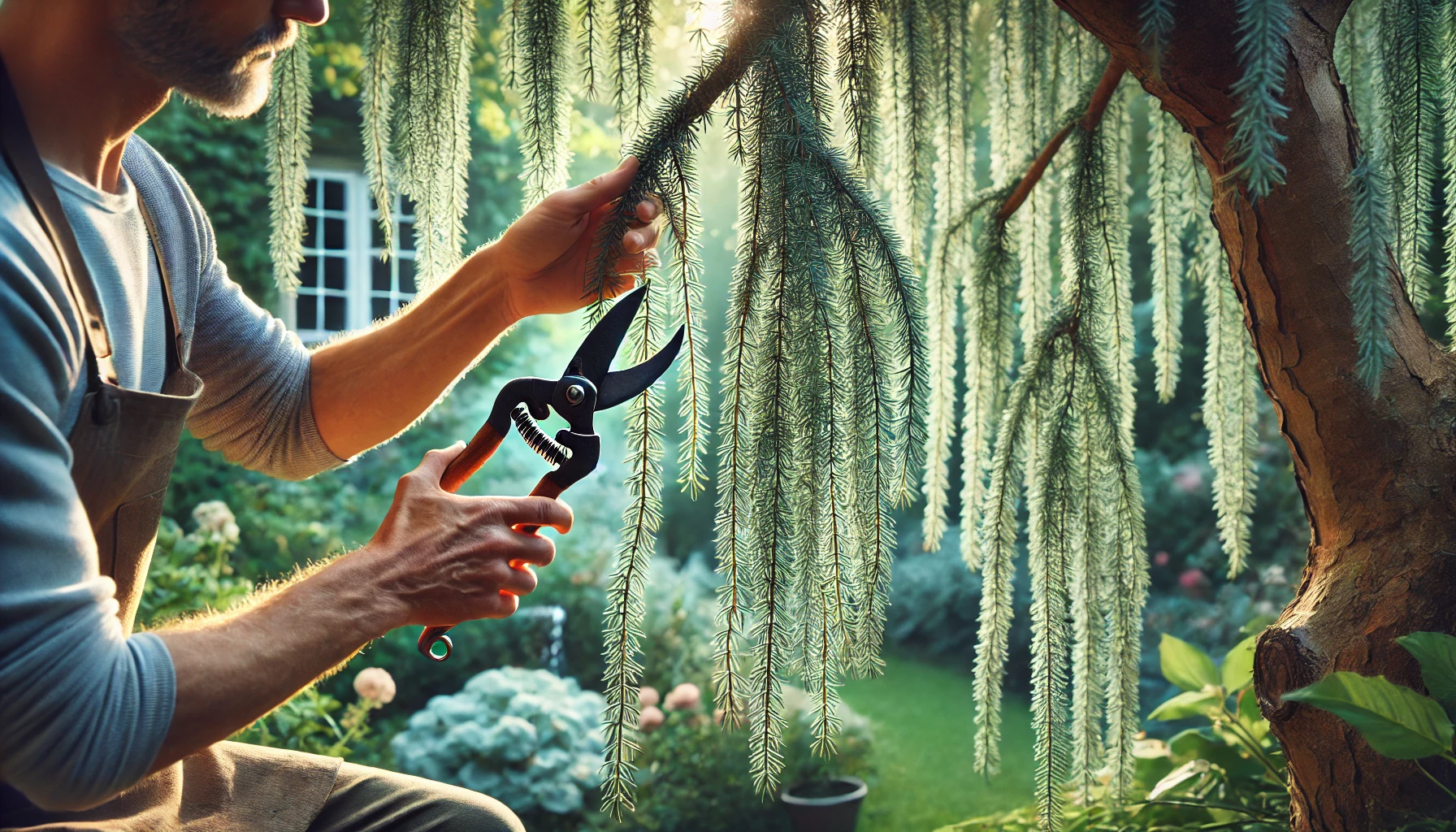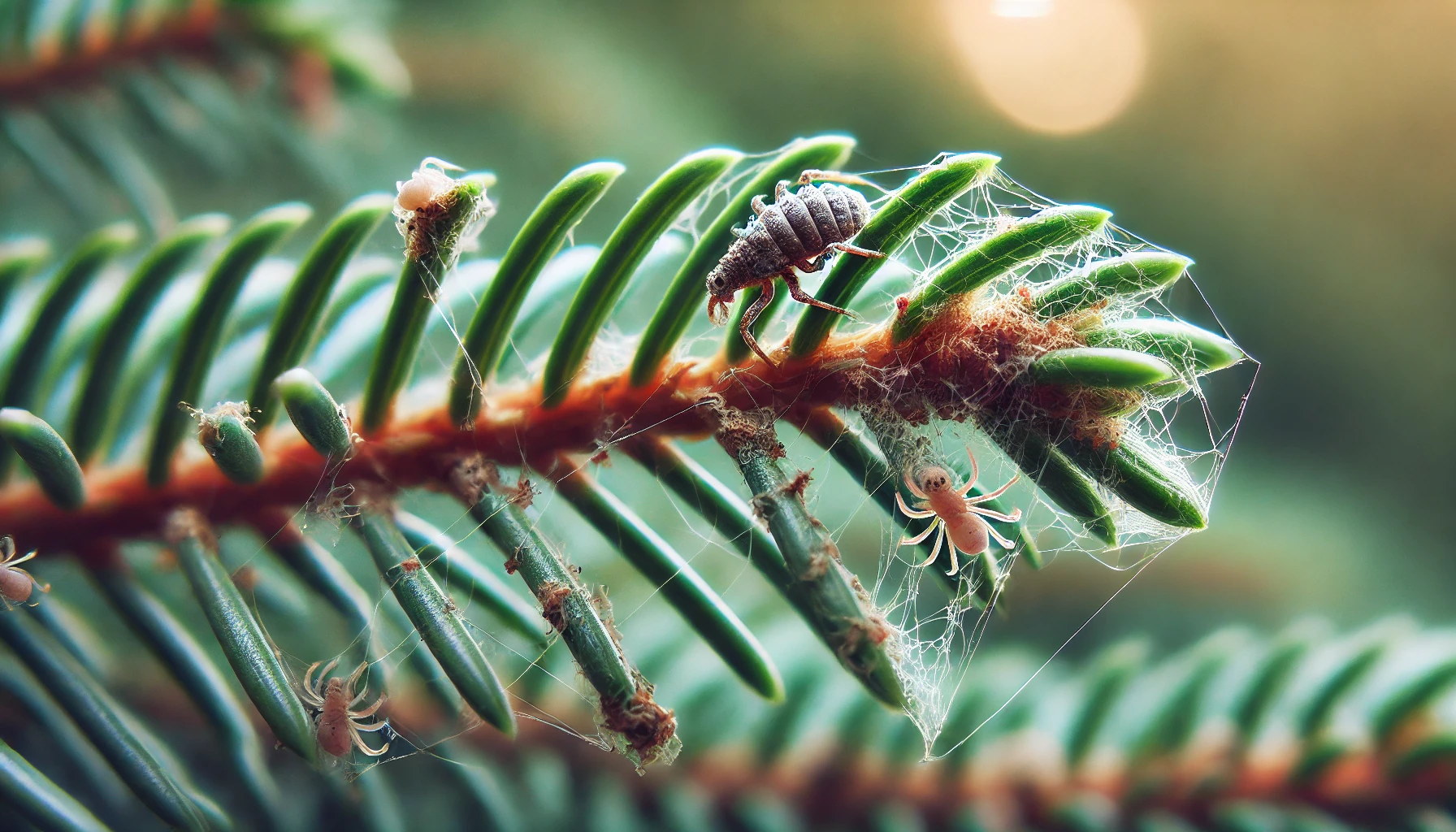
How to Care for a Weeping Pine Tree: Expert Tips for Healthy Growth and Stunning Beauty
Looking to add a unique and stunning touch to your landscape? The weeping pine tree might be the perfect addition! 
In this guide, we’ll share expert tips on how to properly care for a weeping pine tree, including watering, pruning, and ideal growing conditions. Whether you’re a gardening novice or a seasoned enthusiast, these practical insights will help you nurture your tree into a healthy, eye-catching beauty that enhances your outdoor space. Let’s dive in!
Table of Contents
ToggleUnderstanding the Weeping Pine Tree 
The Weeping Pine Tree (Pinus strobus ‘Pendula’) is a captivating and unique variety of pine that adds elegance to any garden or landscape. Known for its graceful, cascading branches, this tree offers a striking visual appeal and a gentle, soothing presence in both large and small spaces. Whether you’re an experienced gardener or a beginner, understanding its needs is key to ensuring healthy growth and long-lasting beauty.

A Quick Overview of the Weeping Pine 
The Weeping Pine is a cultivar of the Eastern White Pine, characterized by its drooping branches that can create a dramatic, weeping effect. These trees are slow growers but can reach heights of up to 10 feet when fully mature. With its soft, long needles and twisting branches, it can become the focal point of your garden, giving a sense of tranquility and movement.
Ideal Growing Conditions 
For your Weeping Pine to thrive, it’s essential to replicate its native environment as closely as possible. Here’s what you need to know:
- Sunlight: Weeping Pines love full sun!
Plant your tree in a location where it can get at least 6 hours of direct sunlight daily. The more sunlight, the healthier and more vibrant your tree will be.
- Soil: Well-drained, slightly acidic soil is the best. Avoid soggy areas that can lead to root rot. Sandy or loamy soils work best for this tree’s root system.
- Watering: While the Weeping Pine is drought-tolerant once established, it still needs regular watering during its first few years. Water deeply during dry spells to ensure the roots stay hydrated, but avoid overwatering as this can harm the tree.

Growth Habits and Size 
As a slow-growing tree, the Weeping Pine’s growth rate may seem modest at first. However, it can eventually reach heights of 6-10 feet with a spread of about 4-6 feet. The tree’s branches grow in a graceful, weeping manner, creating a beautiful, cascading effect. It’s perfect for small spaces, accentuating a garden’s layout or providing a soft, visual barrier.
Why You Should Choose a Weeping Pine 
- Low Maintenance: Once established, the Weeping Pine requires minimal care. It’s a great choice for gardeners who prefer a stunning focal point without a lot of upkeep.
- Unique Aesthetic: The drooping, graceful branches bring a sense of elegance to any garden or landscape, making it stand out even among other pines.
- Versatile: Ideal for both urban and rural settings, this tree works well in gardens, courtyards, or even as a potted plant on a patio. Its shape and size make it adaptable to different environments.
With the right care and attention, your Weeping Pine will grow into a beautiful, low-maintenance tree that becomes the centerpiece of your garden. Keep it healthy with the tips above, and watch it flourish over the years!
Best Planting Practices for Weeping Pine Trees 
Planting a weeping pine tree is a fantastic way to add unique beauty to your landscape. These trees, with their graceful, cascading branches, make a striking addition to any garden or yard. But to ensure your weeping pine thrives, it’s important to plant it correctly from the start. Follow these expert tips to give your tree the best possible foundation for healthy growth and stunning beauty.
1. Choose the Right Location 
Weeping pines prefer full sun, so pick a spot where the tree will receive at least 6 hours of direct sunlight each day. Avoid planting in shaded areas, as this can hinder the tree’s growth and shape. Also, ensure the location is well-drained—wet soil can cause root rot, which can quickly damage the tree.

2. Prepare the Soil 
Weeping pines thrive in slightly acidic, well-draining soil. To improve drainage, you can mix in some sand or organic compost. If your soil is heavy clay, consider planting your weeping pine in a raised bed or mound to prevent waterlogging. You can test your soil’s pH using a simple kit to ensure it’s within the ideal range of 5.5 to 6.5.
3. Dig the Right Hole 
When planting, dig a hole that’s twice as wide as the root ball but no deeper. This allows the roots to spread out easily and encourages healthy growth. Make sure the top of the root ball sits just above the soil level, as burying it too deep can stunt growth and lead to root problems.
4. Handle the Tree with Care 
Be gentle when removing your weeping pine from its container. Gently loosen any tangled roots and avoid disturbing the root ball too much. If the tree is in a burlap sack, remove it carefully to avoid damaging the roots. This helps the tree settle in its new home without stress.
5. Watering Immediately After Planting 
Water your weeping pine immediately after planting to settle the soil around the roots. Keep the soil consistently moist for the first few weeks, especially during dry spells, but avoid soaking it. Once the tree is established, it will be more drought-tolerant, though regular watering is still essential for overall health.
6. Mulch Around the Base 
Mulching around the base of your weeping pine helps retain moisture, regulate soil temperature, and reduce weed growth. Use organic mulch like wood chips or bark, but avoid piling it directly against the trunk, as this can lead to rot. A 2-3 inch layer around the tree’s base is ideal.
7. Provide Enough Space 
Weeping pines can grow wide, so ensure they have enough space to spread out. Plant your tree far enough away from structures, fences, or other trees. Depending on the variety, a mature weeping pine can spread anywhere from 6 to 15 feet wide. Giving it ample space will allow it to grow naturally without obstruction.
8. Protect From Strong Winds 
Weeping pines have delicate branches that can be damaged by strong winds. If you live in a windy area, consider planting your tree in a sheltered location or installing a windbreak like a fence or hedge to protect it.
By following these simple planting practices, you’re setting your weeping pine up for a long, healthy life and a truly stunning presence in your garden.
Remember, proper planting is just the first step—ongoing care will keep your weeping pine flourishing year after year!
Watering and Fertilizing Your Weeping Pine Tree 
Taking care of your weeping pine tree’s watering and fertilizing needs is essential for healthy growth and vibrant beauty. Here’s how you can ensure your tree thrives:
1. Watering Your Weeping Pine Tree 
Weeping pines prefer deep, consistent watering, but they do not like being waterlogged. Here’s how to get it just right:
- Frequency: Water your tree regularly during its growing season (spring through early fall). A general rule is to water once a week, but adjust based on weather conditions. During dry spells, you may need to water more often.
- How Much Water? Aim to water deeply so the moisture reaches the roots. Water until the soil is moist at least 6 inches deep. This ensures the roots get the hydration they need to stay strong and healthy.
- Drainage: Ensure your tree’s location has well-draining soil. Poor drainage can lead to root rot, a common problem for weeping pines. If your soil is heavy or clay-like, consider adding compost or organic matter to improve drainage.
- Avoid Over-Watering: Weeping pines are relatively drought-tolerant, so be careful not to over-water. Let the soil dry out slightly between waterings, especially in the winter months.

2. Fertilizing Your Weeping Pine Tree 
Fertilizing is key to promoting strong, healthy growth. Here’s how to do it effectively:
- When to Fertilize: Weeping pines benefit from light feeding in the spring when new growth begins. This helps them get off to a strong start for the growing season. Avoid fertilizing in the fall, as it can encourage new growth that may be vulnerable to winter cold.
- Type of Fertilizer: Use a slow-release, balanced fertilizer designed for conifers or evergreen trees. Look for one with a balanced N-P-K ratio (nitrogen, phosphorus, and potassium) like 10-10-10 or 14-14-14. This ensures your tree gets the essential nutrients without overwhelming it.
- How to Apply: Apply the fertilizer around the base of the tree, making sure not to let it touch the trunk. Water the area well after applying the fertilizer to help it absorb into the soil.
- Avoid Over-Fertilizing: Too much fertilizer can burn the roots and lead to weak, leggy growth. Stick to recommended amounts and avoid fertilizing too often.
3. Additional Tips for Success 
- Mulch: Adding a layer of mulch around your weeping pine helps retain moisture and regulate soil temperature. Just be sure to keep the mulch a few inches away from the trunk to prevent rot.
- Monitor the Soil: Periodically check the soil moisture and texture to ensure your watering and fertilizing efforts are effective. If the soil is too compact or dry, amend it with compost to improve water retention.
By following these simple watering and fertilizing tips, you’ll help your weeping pine tree stay healthy, vibrant, and a stunning addition to your garden for years to come.
Pruning and Shaping Your Weeping Pine Tree 

Pruning and shaping your weeping pine tree is essential for maintaining its beauty and health. With the right techniques, you can enhance its graceful, cascading look and ensure it thrives for years to come. Here’s everything you need to know about pruning and shaping your tree like a pro!
1. Know When to Prune 
The best time to prune your weeping pine is in late winter or early spring before new growth begins. This gives the tree time to heal and ensures that pruning won’t disrupt its growth cycle. Avoid pruning in late summer or fall, as it can encourage new growth that may not survive the colder months.
2. Use the Right Tools 
A sharp pair of pruning shears or loppers is your best friend for the job. You’ll need a tool that can cleanly cut branches without crushing them. For larger branches, use a pruning saw. Don’t forget to sanitize your tools between cuts to prevent spreading diseases.

3. Remove Dead or Damaged Branches 
Start by cutting away any dead, diseased, or damaged branches. These can detract from the tree’s beauty and may spread illness. Cut back to healthy wood, leaving no stubs behind. If you find any branches that are crossing or rubbing against each other, remove the weaker one to prevent future damage.
4. Shape the Tree 
Weeping pines are known for their beautiful cascading form, so maintaining this shape is key. Gently trim back any overly long or unruly branches that disrupt the natural flow of the tree. Be sure to prune lightly and gradually, focusing on the outer branches to preserve the graceful weeping look. Remember, less is more!
5. Encourage Strong Growth 
If you want to encourage more growth in certain areas, trim the outermost branches to stimulate fresh, healthy growth closer to the center. This helps the tree maintain its balance and prevents it from becoming too sparse in the middle.
6. Be Patient 
Weeping pines grow slowly, so shaping and pruning them requires patience. Don’t expect immediate results. Instead, make small adjustments over time, and let the tree grow naturally into its desired form. With consistent care, your weeping pine will develop its signature cascading shape.
7. Pruning Tips to Remember 
- Always prune at an angle, just above a bud or branch to allow for quicker healing.
- Avoid cutting more than 1/3 of the tree’s overall growth in a single year to prevent stressing the tree.
- Keep an eye on the health of your tree as you prune. If you notice signs of disease, consult an expert before making any cuts.
By following these simple pruning tips, you can ensure that your weeping pine tree stays healthy, vibrant, and beautifully shaped for years to come!
Protecting Your Weeping Pine Tree from Pests and Diseases 

Weeping Pine trees are beautiful, low-maintenance additions to any garden, but they can be vulnerable to pests and diseases if not properly cared for. To ensure your tree stays healthy and vibrant, it’s essential to recognize the signs of trouble early and take preventive measures. Here’s how to protect your Weeping Pine from common threats.
1. Regular Inspection is Key 
Start by inspecting your Weeping Pine tree regularly, especially during the growing season. Look for signs of pests, such as chewed needles or the presence of insects. Also, check for any unusual discoloration or spots on the needles, which could be a sign of disease. Early detection can prevent major damage and keep your tree thriving.
2. Watch Out for Common Pests 
Several pests can harm your Weeping Pine, including:
- Pine Weevil: These small beetles attack the roots and bark, causing significant damage. Look for wilting or browning needles as a sign of infestation.
- Spider Mites: These tiny pests create fine webs on the branches and leaves. They can cause needle discoloration and defoliation.
- Pine Needle Scale: This insect feeds on the tree’s sap, leaving behind a sticky residue and causing needles to yellow.

To manage these pests, consider using organic insecticidal soap or neem oil. Always target the undersides of branches where insects like to hide.
3. Prevent Disease with Proper Watering 
One of the most effective ways to prevent disease is by maintaining proper watering habits. Overwatering or poor drainage can lead to root rot and fungal infections. Water your tree deeply, but make sure the soil drains well to avoid waterlogged conditions.
Also, avoid wetting the needles when watering, as this can promote fungal growth. Instead, water at the base of the tree and ensure the soil is evenly moist but not soggy.
4. Prune Dead or Infected Branches 
Pruning is a great way to maintain the health of your Weeping Pine and prevent the spread of disease. If you notice dead, yellowing, or diseased branches, remove them immediately using sterilized pruning shears. This helps improve airflow and reduces the risk of fungal infections.
5. Fungal Infections: Treatment and Prevention 
Fungal diseases like Dothistroma needle blight and Brown Spot Needle Blight are common threats to Weeping Pines. These fungi can cause needle loss and discoloration. If you spot symptoms, prune away infected branches and treat the tree with a fungicide designed for pines.
To prevent fungal issues, avoid overcrowding around your tree and ensure it gets plenty of sunlight and airflow. These conditions discourage fungal growth.
6. Use Mulch to Protect Roots 
Mulching around the base of your Weeping Pine helps retain moisture and regulate soil temperature. However, be sure not to pile mulch directly against the tree’s trunk, as this can promote fungal growth and rot. A thin layer of mulch, about 2–3 inches deep, around the root zone is ideal.
7. Promote Strong Growth for Natural Defense 
A healthy tree is better equipped to fend off pests and diseases. Feed your Weeping Pine with balanced, slow-release fertilizer in the spring to support healthy growth. Strong, lush foliage is less susceptible to pests and environmental stress.
By following these simple yet effective steps, you can keep your Weeping Pine tree safe from pests and diseases, ensuring it remains a stunning feature in your garden for years to come!
Winter Care for Your Weeping Pine Tree 
Winter can be tough on your Weeping Pine Tree, but with a little preparation, you can keep it thriving even in the cold months. Follow these simple, expert tips to ensure your tree stays healthy and vibrant throughout the season:
1. Protect from Heavy Snow and Ice 
Weeping Pine branches are delicate, and heavy snow or ice can cause them to break or bend. To protect your tree:
- Shake off snow: Gently shake branches after a heavy snowstorm to prevent damage. Be careful not to snap the branches.
- Use a tree wrap: Consider wrapping the tree in burlap or mesh during extreme weather. This provides support and helps reduce the weight on the branches.

2. Ensure Proper Watering 
Even in winter, your Weeping Pine needs water. The dry winter air and lack of rain can leave the soil parched. Here’s what you can do:
- Water before freezing temps: Water the tree thoroughly before the ground freezes. This ensures that it has enough moisture to survive the dry winter months.
- Avoid overwatering: Be mindful not to overwater, as this can lead to root rot. A deep, occasional watering is sufficient.
3. Mulch for Insulation 
Mulching is an easy and effective way to protect the roots of your Weeping Pine from extreme cold.
- Apply a thick layer of mulch (about 3-4 inches) around the base of the tree. This helps insulate the roots and keep them from freezing.
- Keep mulch away from the trunk: To prevent rot, make sure the mulch doesn’t touch the base of the trunk.
4. Shield from Wind Burn 
Cold winds can cause “wind burn” on your Weeping Pine, leading to browning needles and stunted growth.
- Windbreaks: Plant a natural windbreak (such as a fence or other evergreen plants) to shield your tree from harsh winds.
- Wrap with burlap: If wind is particularly harsh, wrap the tree loosely with burlap or tree wrap to prevent wind damage.
5. Avoid Pruning in Winter 
Winter is not the ideal time to prune your Weeping Pine, as it can stress the tree. Pruning during dormancy may also leave the tree more vulnerable to disease.
- Save pruning for late winter or early spring when the tree begins to awaken from dormancy.
By taking these simple steps, your Weeping Pine will be better equipped to handle the winter months. With a little care and attention, it will continue to thrive and add beauty to your landscape year-round!
Conclusion
Caring for a weeping pine tree requires some attention and patience, but the rewards are well worth the effort. With its unique cascading branches and elegant form, this tree can become a stunning focal point in your garden or yard. By following the expert tips shared in this guide—whether it’s choosing the right location, watering properly, or pruning to maintain its shape—you’ll ensure your weeping pine tree thrives year-round.

Remember, regular care and vigilance against pests, diseases, and environmental stressors will help your tree grow strong and healthy. Start implementing these tips today, and watch your weeping pine tree flourish into a magnificent addition to your landscape.
Your beautiful, low-maintenance garden is just a few steps away—care for your weeping pine tree, and it will reward you with stunning beauty for many years to come!
Frequently Asked Questions(FAQ)
How fast does a weeping pine tree grow?
Weeping pine trees are slow-growers. On average, they grow about 6-10 inches per year, reaching a height of 6-10 feet over the span of 10-15 years. Their growth rate can vary depending on factors like location, soil, and care.
How do I maintain the weeping shape of my pine tree?
To maintain the graceful, cascading form of a weeping pine tree, you should prune any dead, damaged, or diseased branches. Also, ensure that the tree receives adequate sunlight and space for the branches to naturally droop. Regular pruning helps encourage the signature weeping growth.
Can I grow a weeping pine tree in a pot?
Yes, a weeping pine tree can be grown in a large pot, especially during its younger years. Be sure to use a container with good drainage and provide plenty of space for root growth. Additionally, make sure to repot the tree when necessary as it outgrows the container.
What type of soil is best for a weeping pine tree?
Weeping pine trees prefer slightly acidic, well-drained soil. Loamy or sandy soil with good drainage is ideal. Avoid heavy clay soil that retains too much water, as it can cause root rot.
When is the best time to prune a weeping pine tree?
The best time to prune a weeping pine tree is in late winter or early spring when the tree is dormant. This minimizes stress and helps the tree heal before the growing season starts. Avoid pruning in the fall, as it may stimulate new growth that could be damaged by winter cold.
How often should I water my weeping pine tree?
Weeping pine trees need consistent moisture, especially during their first few years of growth. Water deeply when the soil is dry, but avoid over-watering, as the tree doesn’t like soggy roots. After the tree is established, it’s more drought-tolerant, requiring less frequent watering.
Are weeping pine trees susceptible to pests and diseases?
Yes, like many pine trees, weeping pine trees can be susceptible to pests like pine beetles and aphids, as well as fungal diseases like needle blight. Regularly inspect your tree for signs of infestation or disease, and treat it with appropriate measures like insecticidal soap or fungicides if needed.
How can I protect my weeping pine tree in winter?
To protect your weeping pine tree during the winter, wrap the tree in burlap or use tree wraps to shield it from cold winds and heavy snow. Water the tree well before the first frost, and make sure the tree is mulched to insulate its roots from freezing temperatures




